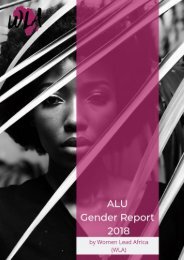You also want an ePaper? Increase the reach of your titles
YUMPU automatically turns print PDFs into web optimized ePapers that Google loves.
African women continue to be the biggest contributors to the informal labour force in their<br />
pursuit of contributing towards economic development. Women have been confined to<br />
small-scale operations in the informal sector and hence their average incomes are relatively<br />
low<br />
Recent research by Pew Research Center showed that, on an analysis of labor statistics in 114<br />
countries, women made up 40% of the workforce in more than 80 countries globally. More<br />
surprisingly, the top 5 countries with the highest female representation in the workforce are<br />
all in Sub-Saharan Africa. Zimbabwe and Malawi lead the list with more than 52% of female<br />
share in the labor force, followed by The Gambia (50.8%), Liberia (50.6%) and Tanzania (50.5%)<br />
Despite this evolution, women are still largely underrepresented in leadership positions in<br />
various corporations hence a need for institutions to start grooming women for the workplace<br />
as early as they can. As women begin to occupy some powerful positions in the world,<br />
prioritizing access to higher education for African women remains essential to ensuring that<br />
they acquire the knowledge and advanced skills critical to take our seat at the table of global<br />
leadership.<br />
ALU definitely is playing a role in changing this narrative. Nearly half of the ALU student<br />
population comprises of females. However, looking closely reveals a less rosy picture and<br />
emphasizes that a lot more can be done to ensure that female students reach their optimum.<br />
11




